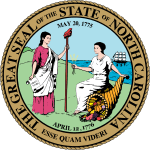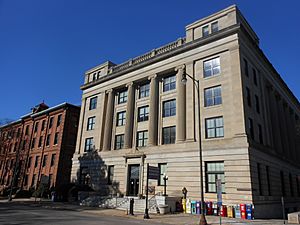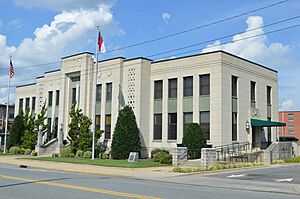Government of North Carolina facts for kids

|
|
| Polity type | Presidential System |
|---|---|
| Constitution | Constitution of North Carolina |
| Legislative branch | |
| Name | General Assembly |
| Type | Bicameral |
| Meeting place | North Carolina State Legislative Building |
| Upper house | |
| Name | Senate |
| Presiding officer | Rachel Hunt, President |
| Lower house | |
| Name | House of Representatives |
| Presiding officer | Tim Moore, Speaker |
| Executive branch | |
| Head of State and Government | |
| Title | Governor |
| Currently | Josh Stein |
| Appointer | Election |
| Cabinet | |
| Name | Cabinet |
| Leader | Governor |
| Deputy leader | Lieutenant Governor |
| Headquarters | State Capitol |
| Judicial branch | |
| Name | Judiciary of North Carolina |
| Courts | Courts of North Carolina |
| North Carolina Supreme Court | |
| Chief judge | Paul Martin Newby |
| Seat | Law and Justice Building, Raleigh |
North Carolina's government is split into three main parts: the executive, legislative, and judicial branches. This setup helps make sure no single part has too much power. The executive branch is led by the Governor and includes the Council of State. The legislative branch is called the General Assembly, which has two parts. The judicial branch is the state's court system, with the North Carolina Supreme Court at the top. The Constitution of North Carolina explains how all these parts work together.
Contents
Executive Branch: Leading the State
The executive branch of North Carolina's government is described in Article III of the state constitution. This branch is responsible for carrying out the laws.
Who is in the Executive Branch?
The first North Carolina Constitution in 1776 set up a governor and a seven-member Council of State. Today, the Council of State has ten members. Voters choose these members. They include:
- Governor
- Lieutenant Governor
- Attorney General
- Secretary of State
- Commissioner of Agriculture
- Commissioner of Insurance
- Commissioner of Labor
- Superintendent of Public Instruction
- State Treasurer
- State Auditor
The Council of State doesn't have many responsibilities as a group. However, some laws give it power in specific situations. This includes when the state buys property.

The Governor also appoints leaders for ten North Carolina Cabinet departments. These departments help manage different areas of the state. They are:
- Department of Administration
- Department of Commerce
- Department of Natural and Cultural Resources
- Department of Environmental Quality
- Department of Health and Human Services
- Department of Information Technology
- Department of Revenue
- Department of Public Safety
- Department of Military and Veterans Affairs
- Department of Transportation
North Carolina also has three independent executive agencies. These are the Office of Administrative Hearings, the Office of the State Controller, and the State Board of Elections.
Legislative Branch: Making Laws
The legislative branch gets its power from Article II of the North Carolina Constitution. This branch is the North Carolina General Assembly, which is the state's law-making body. Like almost all other states, North Carolina has a legislature with two parts, meaning it is bicameral.
How the General Assembly Works
The General Assembly has 120 members in the North Carolina House of Representatives. It also has 50 members in the North Carolina Senate. The Lieutenant Governor is the president of the state Senate. The Senate also chooses its own president pro tempore. The House of Representatives elects its speaker.
The North Carolina Constitution gives the General Assembly the power to create state laws. The assembly can also collect taxes and approve the state's budget. Only the General Assembly can suggest changes to the state constitution. If three-fifths of both the House and Senate agree to a change, it goes to a statewide vote for approval.
Judicial Branch: Interpreting Laws
North Carolina's judicial branch gets its power from Article IV of the North Carolina Constitution. The current court system was set up in the 1960s. It is called the General Court of Justice.
Parts of the Court System
The General Court of Justice has three main parts:
- The District Court Division
- The Superior Court Division
- The Appellate Division
The Administrative Office of the Courts manages all the office work and money for the state court system.
Supreme Court of North Carolina
The Supreme Court of North Carolina is at the top of the General Court of Justice. It is part of the Appellate Division. The Supreme Court has one chief justice and six associate justices. Voters choose all of them to serve eight-year terms. The main job of this court is to decide legal questions from lower courts. It often handles cases about the constitution and important legal issues. It also hears appeals for serious criminal cases.
North Carolina Court of Appeals
The North Carolina Court of Appeals is the state's middle-level appeals court. It has fifteen judges who work in groups of three. They hear appeals from lower courts. The Supreme Court and the Court of Appeals together form the appellate division.
Superior Court Division
The Superior Court is the main trial court in North Carolina. In criminal cases, it handles all serious crimes called felonies. It also hears appeals for less serious crimes from District Courts. In civil cases, it handles disagreements where the amount of money involved is more than $25,000. The Superior Court also hears most appeals from state agencies.
District Court Division
In criminal cases, the District Courts handle less serious crimes and minor offenses without a jury. They can also try some low-level felony cases if everyone agrees. In civil cases, these courts handle disagreements involving less than $25,000. They also handle divorces, child custody issues, and child support payments. Magistrates in these courts can issue arrest warrants, perform marriages, hear small claims cases, and order people to get mental health help if needed.
Local Government: Serving Communities

How Local Governments are Formed
The General Assembly has the power to create local governments. This power comes from Article VII of the Constitution of North Carolina. Local governments in North Carolina are mostly counties, cities, and towns. There is no legal difference between a town and a city; it's just a choice of name. North Carolina has 100 counties and more than 552 municipalities (cities and towns).
There are also special purpose governments. These often deal with things like soil and water conservation or housing. Some local governments work together in regional groups. This helps them coordinate and cooperate better.
Counties: Local Administration
Every part of North Carolina is in a county. An elected board of commissioners leads all counties. This board hires a county manager. Boards of commissioners can have from three to 11 members. Besides the manager, they usually hire the county's clerk, attorney, assessor, and tax collector.
County governments in North Carolina also have other elected officials. These include sheriffs and registers of deeds. These officials control their own staff. The office of county sheriff is set up by the constitution. Sheriffs are not under the direct control of the state government. County governments get most of their money from local property taxes. All counties are divided into townships. Townships no longer have legal power but are used for organizing administrative tasks.
County governments in North Carolina include these officials:
- Sheriffs
- County commissioners
- Register of deeds
- Clerk of court
- Alcoholic Beverage Control Board
- Board of Education
- Board of Elections
- Public Health Board
- Mental Health Board
- Social Services Board
Municipalities: Cities and Towns
North Carolina is a Dillon's rule state. This means cities and towns can only use powers that the General Assembly or state constitution clearly gives them. Most cities and towns in North Carolina use a council-manager government. Some use a mayor-council government.
All municipalities have an elected governing board. This board might be called a city council, town council, board of commissioners, or board of aldermen. Some of these municipalities have mayors. The mayor leads the elected city council, which makes local government rules and sets the city budget. Most mayors are elected by the people and usually don't vote in council meetings. The council hires the city manager. The manager is the main executive officer of the city. They are in charge of city employees and carrying out policies. Smaller towns might not have a manager.
The state constitution allows for combined city-county governments. However, Camden County is the only place in the state that currently works this way.
Special Purpose Districts
Special purpose districts are local governments that can collect taxes for specific jobs. They have a very narrow focus. Common examples are districts for sanitation or rural fire protection. Authorities are similar but cannot collect taxes. Common authorities include those for housing, water and sewer, and airports.
See also
- Politics of North Carolina
- List of governors of North Carolina
- Law of North Carolina



